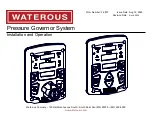
Teardrop Campers • nucamprv.com
36
nucamprv.com • Teardrop Campers
37
WASTEWATER HOLDING SYSTEM
The wastewater system has two holding areas. The gray tank stores
wastewater from the shower and sinks while the black tank stores solid
wastes from the toilet.
• Smells from the black tank can be unpleasant. Use of an RV
holding tank deodorizer will reduce the smell and aid in breaking
down solids. Make sure to follow manufacturer instructions when
operating and maintaining the toilet.
• Unpleasant odors from the gray tank can be controlled by adding
½ cup of baking soda or RV holding tank deodorizer to the sink or
shower drains and rinsing down with water.
• Keep the knife valve locked and the drain cap tightly in place when
using the system on the road and anytime not connected to a
dumping station.
• Use a special holding tank deodorant chemical approved for RV
holding tank systems in the black and grey water holding tanks.
These chemicals aid the breakdown of waste and make the system
more pleasant to use.
• Do not put facial tissue, paper, grease, ethylene glycol-based or
other automotive antifreeze, sanitary napkins or household toilet
cleaners in the holding tanks.
• Do not put anything solid in either the gray tank or cassette pod
that could scratch or puncture.
TOILET
The toilet is connected to the pressurized fresh water system. A single
lever arrangement controls the flushing and the flow of water into the
bowl. Most RV toilets are designed to function with a smaller amount of
water than household toilets. Unnecessary, frequent flushing of the toilet
will quickly deplete your fresh water supply and fill the black tank. If the
black tank becomes full, the toilet cannot be used until the tank
is drained.
To keep black tank blockage to a minimum:
• Cover the bottom of the cassette pod with water immediately
after dumping.
• Movement while driving will help liquefy solids in the black tank.
Adding water to the tank will also help
• Only use an RV approved biodegradable 1-ply tissue paper and
deodorizing agents specifically designed for use in RV holding tank
systems. These products are available directly from your dealer and
most camping supply stores.
• Never use chlorine or caustic chemicals such as drain opener or
laundry bleach in your toilet.
• Never allow foreign objects (non-dissolving items) such as hygiene
products, paper towels, wipes, or diapers to be flushed through
the toilet.
Refer to the Owner’s manual included in the owner’s packet or in the
packaging of your toilet for operating and detailed care instructions.
WINTERIZING/DE-WINTERIZING
Freezing climates can damage the camper’s plumbing system and
equipment. The camper must be drained, blown out and have antifreeze
protection before storing or camping in below freezing temperatures in
fall/ winter. This is done through a process called winterizing.
When getting the camper ready for camping season in spring you must
cleanse the potable fresh water system to remove all the antifreeze. This
process is called de-winterizing or sanitizing.
User instructions for winterizing, de-winterizing and sanitizing can be found
on the Nautilus plumbing control panel manufacturer’s website at:
http://www.bandbmolders.com/index.php/p3-2/
Keep drain valve closed to minimize the
presence of sewer gases. Sewer gases
can be present when RV is connected to
campground sewage hookup. May lead
to illness or personal injury.
CAUTION
There is a secondary method of
winterizing that does not use RV
antifreeze. The line is simply blown out
with a blowout plug and no antifreeze is
added. Since there is a risk involved with
this method if the system is not blown
out thoroughly, nuCamp recommends
the RV antifreeze winterizing method
as a safer option. If you wish to try the
blowout method consult your dealer for
instructions and training. Pressure in the
lines must never exceed 50 PSI when
blowing out the water system.
NOTICE
















































